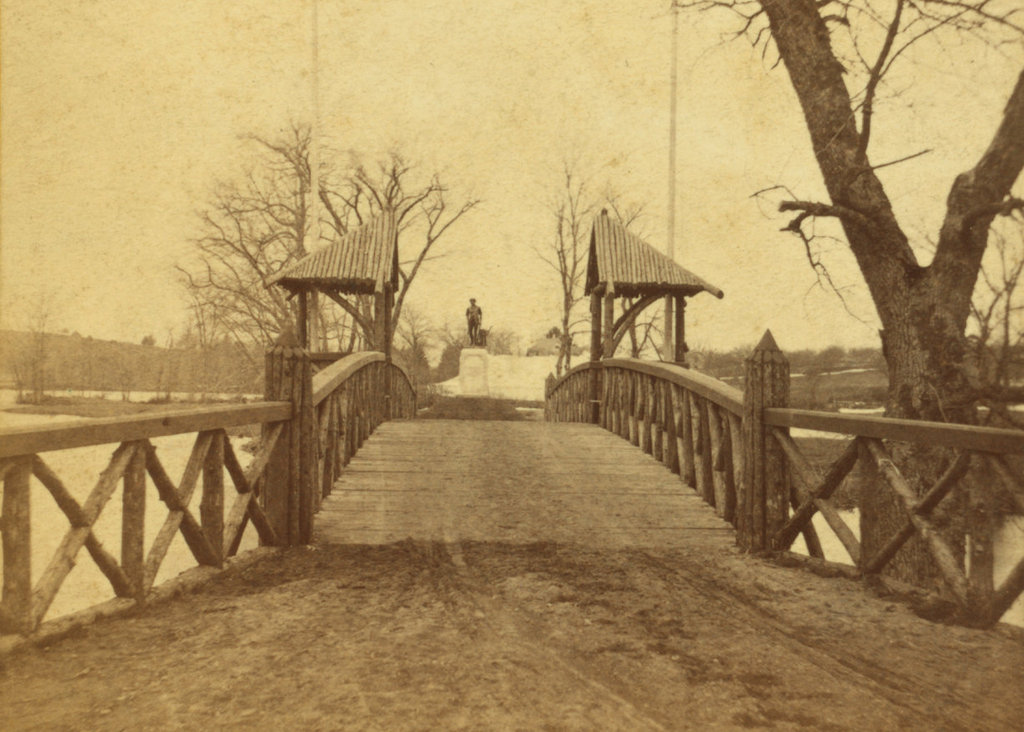“Grave of British Soldiers Opened”
In the late 1800s, the Google Book Ngram Viewer shows, there was a spike in the use of the phrase “Old Concord.” That seems to be an effect of the Colonial Revival and nostalgia for pre-industrial America, including not only the Revolution but the “American Renaissance.” Margaret Sidney wrote a book with that title.
On 25 Aug 1895, the Boston Sunday Globe played off that newish trope with an anonymous article headlined “IN NEW CONCORD.”
The subheads were:
Like George F. Hoar, Tolman appears to have been protective of his town’s reputation. This page shows him stating that a British soldier whom militiaman Amos Barrett described as “almost dead” was “quite dead a few moments later” without reporting that the change was brought about by a young local striking that wounded soldier’s head with a hatchet.
Whoever wrote the Boston Sunday Globe article wasn’t so reticent. In fact, that journalist didn’t just describe how a young man delivered “a coup de grace with an axe.” He or she was also, so far as I can tell, the first person to name that man in print as Ammi White.
The upshot of this article is that the secret reburial of the British soldier’s skull in 1891 was a matter of public record, or at least public gossip, in 1895.
TOMORROW: A “demoralized” skull?
(The photo above, courtesy of the New York Public Library and Lost New England, shows Concord’s North Bridge as it looked around 1885, before it was pared back to look like the bridge in the Amos Doolittle print.)
On 25 Aug 1895, the Boston Sunday Globe played off that newish trope with an anonymous article headlined “IN NEW CONCORD.”
The subheads were:
Only Pilgrims Preserve its Old Traditions.The article was gossipy, not easy to follow unless one already knew a bit about Concord already. There were inside anecdotes about the Hoar family. After discussing the 1889 attempt to break into Ralph Waldo Emerson’s grave, the journalist segued to:
“Immortals” Seem as Remote as Actors in Revolutionary Drama.
Grave of British Soldiers Opened—Changes Among Inhabitants.
There was another and more successful violation of a grave in Concord a long time ago, the story of which has never been published, and which will be interesting to the recent visitors to the revolutionary sites there. . . .George Tolman (1836–1909) was secretary of the Concord Antiquarian Society and wrote many articles for that organization. Here’s a collection of his work and others catalogued under the title of one paper only. Though Tolman’s name didn’t come up in yesterday’s source, he may well have been involved in an effort to get the skull from Worcester.
Somewhat more than 50 years ago a phrenologist named Felt [sic] was lecturing upon his science in Concord. The story runs that he obtained permission from some authority to open and examine the soldiers’ grave, which he interpreted as a license to make what professional use he pleased of the remains therein.
At all events, Felt took the two skulls from the spot and carried them off, and as far as is known, nobody in Concord was any the wiser for nearly half a century!
Only five or six years since Mr George Tolman of the Concord historical society heard to his surprise that a skull marked as one of the British soldiers buried at Concord was in the museum of antiquities at Worcester.
Investigation showed that it was given by Mr Daniel Seagrave, a member of the society, and a worthy citizen of that town, still living. He had been a fellow-member of a lodge with Felt, and when the latter died at Natick [sic] many years ago he had assisted the widow with the funeral expenses, and had bought these two skulls, one of which was pierced with a musket shot and the other shattered as if with an axe. The shattered skull had been given to a surgeon in Worcester, and had been placed with other bones, so that it was not recognizable.
The other was courteously and promptly given up by the Worcester society, and was reverently restored to its resting place by Judge [George M.] Brooks, the president of the Concord antiquarian society.
As a verification of the story of the abstraction of the heads, which seemed perfectly coherent and plausible, it may be said that, though the other bones were distinctly seen, no traces of the skulls, the most enduring portion of the human skeleton, were found.
Like George F. Hoar, Tolman appears to have been protective of his town’s reputation. This page shows him stating that a British soldier whom militiaman Amos Barrett described as “almost dead” was “quite dead a few moments later” without reporting that the change was brought about by a young local striking that wounded soldier’s head with a hatchet.
Whoever wrote the Boston Sunday Globe article wasn’t so reticent. In fact, that journalist didn’t just describe how a young man delivered “a coup de grace with an axe.” He or she was also, so far as I can tell, the first person to name that man in print as Ammi White.
The upshot of this article is that the secret reburial of the British soldier’s skull in 1891 was a matter of public record, or at least public gossip, in 1895.
TOMORROW: A “demoralized” skull?
(The photo above, courtesy of the New York Public Library and Lost New England, shows Concord’s North Bridge as it looked around 1885, before it was pared back to look like the bridge in the Amos Doolittle print.)


No comments:
Post a Comment